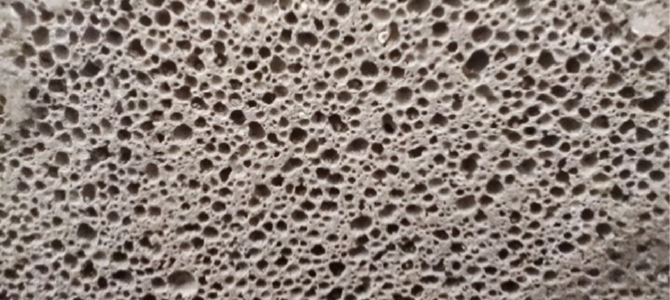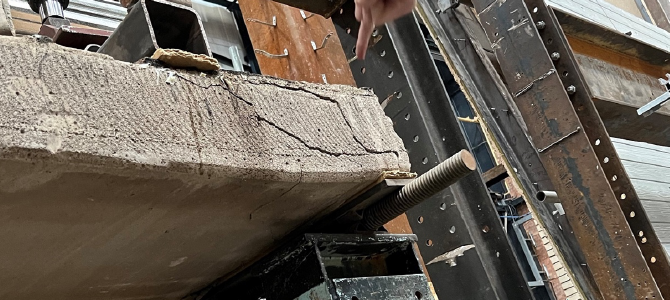Research
RAAC - Reinforced Autoclaved Aerated Concrete
In the wake of news items during 2023 warning of school buildings in England being at risk of collapse, these pages of our website explain what ‘RAAC’ is, why it is considered a safety risk, and what is being done nationally to address the issue.

What is RAAC?
RAAC stands for: R: Reinforced A: Autoclaved. A: Aerated. C: Concrete
Like many countries, the UK has an old building stock, which needs to be adequately repaired and maintained. In the post-war period the country built numerous new buildings with a variety of different methods, many of which are now feeling their age.
One innovative construction material and process was RAAC, which is an aerated lightweight cementitious material with no coarse aggregate; the material properties and structural behaviour therefore differs significantly from ‘traditional’ reinforced concrete.
Tens of thousands of these structural panels exist across a broad cross-section of buildings, many constructed in the 1950s, 60s and 70s, and many are showing signs of wear and tear and deterioration. The vast majority form the roof of the structure, usually flat, and hence are difficult to access, survey, maintain and replace.
Why RAAC is considered a safety risk?
The Standing Committee on Structural Safety (SCOSS) report issued in May 2019 highlighted the significant risk of failure of these panels. In September 2022, the Office of Government Property sent a 'Safety Briefing Notice’ to all Property Leaders, regarding the dangers of RAAC, stating that ‘RAAC is now life-expired and liable to collapse’.
It is therefore essential that those responsible for the management, maintenance or alteration of buildings know whether their buildings contain RAAC, and if they do not know, they should seek appropriate expert advice. If not properly managed, RAAC panels are structural building components with safety implications.
It is RAAC from the 1950s, 60s and 70s that is of main concern, especially if it has not been adequately maintained. RAAC examples have been found with bearings (supports) which are not big enough, and RAAC with the steel reinforcement in the wrong place, both of which can have structural implications. Prolonged water ingress (not uncommon on old flat roofs) can also lead to deterioration.
RAAC however, is still manufactured and installed all over the world. It can be an appropriate construction material if properly designed, manufactured, installed, and maintained. Our research has shown however, that this is often not the case for RAAC panels constructed in the 1950s, 60s and 70s.
What is being done nationally?
NHS England/Improvement is at the forefront of understanding and tackling the issue and have issued instructions requiring the removal of RAAC panels by 2030.
Nationally there are seven Trusts that have buildings predominately constructed of RAAC. They have commissioned research, led by Loughborough University, to help them better understand the unique nature of the material and the problem, and hence make appropriate decisions.
The Department for Education (DfE) has requested all of the country’s 20,000+ schools to check if they contain RAAC, but some still have not, and hence urgently need to. Several have found RAAC and have been advised to seek expert guidance from a qualified Structural Engineer. The DfE has recently updated its guidance on how to find RAAC and what to do. In March 2022 the DfE opened a questionnaire in relation to RAAC in school buildings. Many responses are still outstanding however, and the LGA (Local Government Association) is strongly advising all responsible bodies to respond to the DfE RAAC survey as soon as possible.
The Ministry of Defence also issued a safety alert in 2019 on the back of the SCOSS report and are also investigating the problem.
The Institution of Structural Engineers currently has a RAAC Study Group and published guidance in February 2022, into which the research at Loughborough contributed.
ITV have shared their 2023 report on RAAC in a YouTube video.
The role of AI

A “first of its kind” AI tool, that aims to cut the amount of time and resources needed to survey and maintain Reinforced Autoclaved Aerated Concrete (RAAC) in buildings nationally, has been developed by researchers at Loughborough University.
The digital tool uses software, produced by academics within the University’s School of Architecture, Building and Civil Engineering, and thousands of images to detect any ongoing deterioration within RAAC– highlighting the location and proposed lifespan of cracks within the concrete.
The project came about following work identifying RAAC faults within NHS buildings. There was no unified approach to how data was being collected so it was necessary to start collecting data that was less based on the manual surveying processes and more to do with what could be captured as real and accurate data. The estates were provided with a systematic process for collecting photographic records. Through this imagery it is possible to start to recognise the cracks that are in place and, in time, to recognise individual cracks and see if they increase or decrease.
At the moment, numerous institutions are inspecting their RAAC buildings across a range of sectors. Our advice is that if RAAC is in a poor condition it should be inspected monthly. if it's a medium risk, it should inspect every six months. If it’s low risk, it should be inspected every year.
Some NHS trusts have large teams of people dedicated to inspecting RAAC in their buildings. This process is extremely time consuming and, as there are many planks that are likely to be in place, it could lead to inspections that are not comprehensive or effective. The AI tool provides a far superior process - reducing the time and number of people involved drastically, allowing better focus resources.
With the breadth of AI being so vast, it has been important for the research team to provide training in its use: which of the many thousands of images showed cracking and which didn’t; emphasising the difference between, for example, hairline cracks and spider webs It is now proven that the whole RAAC maintenance process can be fastened and simplified. There is a code that can be run from any laptop and used by anyone. For instance, if a hundred pictures from surveying are run through our code, the code will separate the images that show cracking from those that don’t. With the addition of timestamps, we can then capture how these planks are being impacted over time. It allows us to be as objective as possible.
With the process easy to us, the tool should work hand in hand with manual checks and, for the time being, not act as a replacement: As of 2023, the tool is currently 95% accurate so need manual checks still need to be in place but what the AI tool does is to increase the data’s objectivity. In the future it is hoped that the AI system will develop n sophistication and reduce the time required for inspection even further.
With Britain’s building stock being one of the oldest globally, this tool could really assist in the long term. Without a smart asset management system it is difficult to manage building stock and apply, for example, the Building Safety Act properly. To monitor buildings that are 30, 50, 100 years old and start to build up information on the materials and the properties of those buildings and then extend them for another 50 years it is going to be necessary to develop a way to create a transferable knowledge pool. The most effective way is through a digital interface and a digital asset management system. This tool would be the bedrock of that system.
Academic Team
The experienced team at Loughborough University, of which Professor Chris Goodier, Professor Gorse and Dr Blay are a part, are leaders on research into RAAC. These inspection processes benefit hugely from the state-of-the-art laboratories and modelling capabilities available to them at the University.


